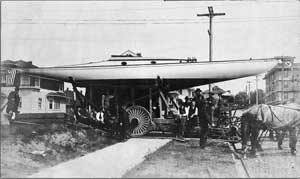 |
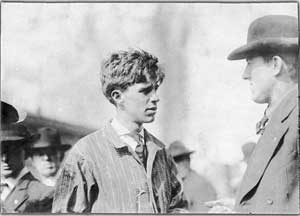 |
As time went by, I learned that Geary had not confined his talents to motoryachts but had also designed and raced some extraordinarily fast sailboats. Many of his boats, motor and sail, are still with us, looking as good as they did six and seven decades ago-a tribute to the genius of their creator and the craftsmen who executed his splendid designs. Such men and boats should not go unremembered.
 |
 |
Ted's early life was dominated by the waters surrounding Seattle. He had three younger sisters, Grace, Gladys, and Gwendolyn, but as the only son, Ted seems to have enjoyed a great deal of latitude in his activities, and his childhood is replete with water-oriented adventures, most of which were entered into with his inseparable friends, Lloyd and Dean Johnson.
Many of Ted's escapades occurred on school days, and he was a chronic truant. It wasn't that he was a poor student; in fact, his grades were always high. It was simply that Ted preferred being on the water with his pals to being cooped up in a classroom. An oft-told family story relates that, after Ted had been expelled for a third time, his father finally told him, "You got yourself kicked out, so you can just kick yourself back in ...." Evidently the youngster managed to do just that.
There are many tales of Ted's antics: At the age of nine, he fitted
a gunny-sack sail to a 9 x 3' canoe he had built, and spent many a day
sailing it around Elliott Bay. In 1897, in a later 16' sailing canoe, Ted
and Lloyd Johnson circumnavigated Seattle. Starting early one morning from
Budlong's Boat House on Lake Union, they portaged into Lake Washington,
sailed to the south end of the lake into the Black River, which then drained
the lake, down the Black to the Duwamish River, and then into Elliott Bay
on Puget Sound, arriving at about 8 p.m. After a night's sleep on the boathouse
dock at the end of Battery Street, the two boys paddled out around West
Point through Salmon Bay and up the creek that is now the Lake Washington
Ship Canal, portaged over the Brace and Hergert Sawmill property where
the Fremont Bridge now stands, and arrived back at Budlong's at 2 p.m.
Local legend recalls that Ted and Lloyd used to paddle the same canoe out
to the bell buoys in Puget Sound, where they would tie up and spend hours
watching the wind and tide.
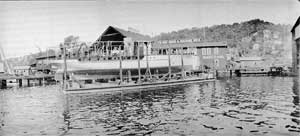
In 1899, aged 14, Ted, along with Russell Wayland, built the 24'
centerboard racing sloop EMPRESS to Ted's design. For four years, the two
friends raced EMPRESS and won many races with her. Then, in 1905, Ted designed
and, with the Johnson boys, built EMPRESS II, another 24' centerboard sloop-she
was never defeated and thrust the young Geary into prominence on the local
racing circuit.
After graduation from Seattle High School (now Broadway High School) in 1904, Ted enrolled in the School of Engineering at the University of Washington, which he attended in 1905 and 1906. During the spring of his second year, he contracted cholera and, while recuperating, designed SPIRIT, a 42' LOA x 28' 7" LWL x 8'6" beam sloop with which Seattle Yacht Club challenged the Canadian yacht ALEXANDRA (48' x 29'3" x 8'2") for the Dunsmuir Cup. ALEXANDRA, designed by William Fife of Fairlie, Scotland, and built in British Columbia, was considered the fastest thing afloat by the Canadians; but it was SPIRIT, skippered by Ted Geary, that won the three race series of 1907.
The next year, however, with Geary again at the helm of SPIRIT, it was ALEXANDRA that won the event, in three very close races held in Vancouver. Unwilling to take defeat lying down, Seattle yachtsmen commissioned Geary to design and build a second SPIRIT in 1909. By this time, Geary was enrolled at MIT studying marine engineering and naval architecture, and SPIRIT II was completed while he was still a student there. Technically, SPIRIT II won the ensuing race series, but the event led to a rift between the British Columbia and Seattle sailing fraternities: An argument arose concerning the method of measurement used for the American boat. SPIRIT II won the first race, but ALEXANDRA was withdrawn before the start of the second and was sailed home to Vancouver. As a result of the dispute, there was no racing between the two yachting centers for the next four years.
A group of prominent Seattle businessmen, who were impressed with Geary's outstanding sailing skills and his ability to design boats, paid for his tuition at MIT, and it is to Ted's everlasting credit that, in the following years, he repaid all his sponsors from the proceeds of his design work. Graduation from MIT came in 1910, and Geary returned to Seattle where he was soon in the mainstream of his chosen profession.
Many of his benefactors and admirers were influential in both the local lumber and fishing industries, and Geary was soon receiving commissions for commercial craft such as logging tugs, cannery tenders, fishing vessels, passenger ferries, fire boats, and fishery patrol craft. His business flourished from the start and, over the next two decades, evolved into a mature practice of handsome working boats. Indeed, the epic book H. W. McCurdy's Marine History of the Northwest abounds with references to commercial vessels designed by Geary between 1911 and 1938. One notable example was CHICKAMAUGA, the first diesel-powered tugboat in the U.S. and a boat that set the trend, which, within four decades, would result in the virtual elimination of the steam engine in the nation's towing fleets. Built in 1911, the 70' tug was sturdily built with 2 3/4" fir planking on 10" frames, and was still hard at work for Pacific Tow Boat (now a Foss subsidiary) as late as 1966. When he designed her, Geary was just 25 years old.
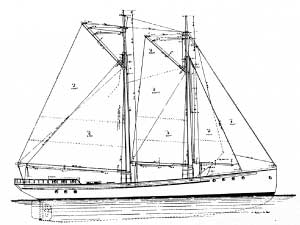 |
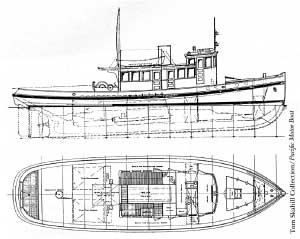 |
The Seattle contingent ordered three new boats: Leigh Coolidge designed DEFENDER, to be built by the Rohlf brothers (who had built both SPIRITS) and skippered by Adolph Rohlf; Ted Geary, as part of a Seattle Yacht Club syndicate, drew up SIR TOM (named in Lipton's honor), to be built by his boyhood pals Lloyd and Dean Johnson and Norm Blanchard in their shop at Georgetown on the Duwamish River; the third boat, SPRAY, was designed, built, and sailed by her owner Quint Williams.
After a series of trial races in which SIR TOM demonstrated her superiority
over both DEFENDER and SPRAY, Geary's yacht was selected to be the first
defender of the new cup and to meet the Vancouver boat, TURENGA, designed
by Edson B. Schock, and sailed by top Canadian skipper Ron Maitland.
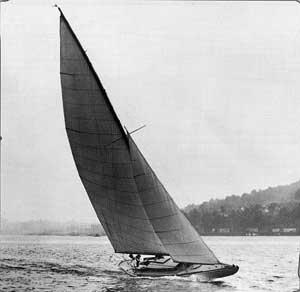
SIR TOM, skippered by her designer, handily won the first series
in two races, and thus began a career in which she was to hold the Lipton
Trophy and the Isherwood Cup (trophy of the Pacific Coast Championship
for the R class) for the next 14 years, and the Pacific Northwest R-class
title for the next 17 years. SIR TOM's phenomenal history will be expanded
upon in the next issue; suffice it to say, here, that she consistently
defeated many boats by top designers such as Charles E. Nicholson, Edson
B. Schock, John G. Alden, Charles D. Mower, Nicholas S. Potter, William
Gardner, George Owen, and others of similar talent. SIR TOM's longevity
at the top was unparalleled in any other class.
With the creation of SIR TOM, Ted Geary more than fulfilled the "boy wonder" appellation that had been bestowed upon him some years before, but his boyish enthusiasm was to remain, and he continued to throw himself into all sorts of marine-oriented projects that were to benefit both the sport of yachting, and, more important, the entire maritime community, commercial as well as recreational.
Throughout his career there is evidence of Geary's dedication and commitment to marine safety. A 1911 news article described, with photographs, the daring test demonstration of a newly patented lifeboat releasing device in which Ted had an interest. In front of U. S. Maritime Inspectors, shipmasters, ship owners, and the press, an open lifeboat with Geary aboard-was released from the davits of the steamer INDIANAPOLIS, while she was making 18 mph. The article stated that INDIANAPOLIS was known for her considerable wash, and few who had gathered to witness the event had expected either Geary or the boat to survive. The lifeboat struck the water with a great splash, and the cloud of water and spray hid her for a few long moments before she was seen bobbing in the ship's wake. Ted was uninjured and not even damp, and the boat had shipped virtually no water.
Geary was also long and enthusiastically involved in youth sail-training programs, and advocated that future sailors, both boys and girls, should be given early instruction in on-the-water fundamentals. He believed that city-sponsored sail-training programs and facilities, along with model-building projects, were excellent ways to get young people started. In support of this cause, Geary wrote many articles in both local as well as Los Angeles newspapers, and often accompanied his words with annotated plans. His writing inspired model building classes in manual training departments of Seattle and Los Angeles high schools.
Doug Egan, who, as an adult in the mid-1920s, sailed SIR TOM with Ted, recalled that Geary would sometimes come out and sail with the Seattle Yacht Club juniors during their hotly contested races on Portage Bay. "It was a great treat to have him come aboard to coach us on some of the finer points of racing, and I am sure he enjoyed being with us ...always with his infectious smile and calm and deliberate manner." The eventual result of Geary's interest in youth sailing came in 1928 when he designed the Flattie (now known as the Geary 18), which was a boat that young people could easily build and then sail and race.
 |
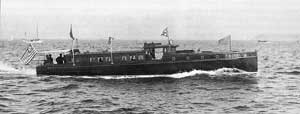 |
The country was gearing up for World War I, and for the next few years commercial and government work dominated builders and designers alike. In 1917, Geary was appointed naval architect to the Northwest Division of the Emergency Fleet Corporation and was given charge of building 93 wooden ships, which culminated in the 5,400 ton Geary-class cargo vessels BROXTON and SNOQUALMIE.
These 330' LOA x 49' beam x 39' draft single-screw, wooden steamships were built by Puget Sound Bridge & Dredging Company of Seattle, and were completed in 1918. Billed as the largest wooden carriers in the world., the Geary class was intended to replace the smaller Ferris type (3,500 tons) previously built for the emergency fleet. BROXTON made 11.28 knots in her sea trials, but, even as she was launched, the war was nearly over. Nevertheless, both steamships were completed and used commercially for hauling lumber from British Columbia to Australia.
At war's end SIR TOM was rebuilt after a period of inevitable neglect, and soon both boat and crew were back into their winning ways - it was as if they had never stopped. Ted was a natural sailor and a superb helmsman. Ebullient, daring, and confident, he had an uncanny ability to sense wind shifts and gusts at considerable distances and thereby put his boat to best advantage. He was also known to have intense powers of concentration and a very cool head in racing situations. His daughter, Sharon, related how Ted once fainted seconds after winning a very close and important race - it's a curious contrast to the lighthearted geniality and easy good sportsmanship for which he was well known. SIR TOM continued at the top of the R class, and her skipper's celebrity, coupled with his burgeoning reputation as a naval architect and his outgoing and naturally friendly personality, opened many doors-both professional and social. He was welcomed wherever he went, and his career prospered.
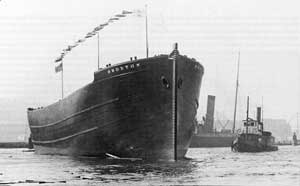 |
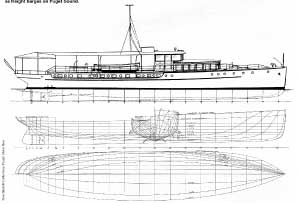 |
At the end of the racing, Geary and Norm Blanchard were invited to the
home of Mr. Willits J. Hole to discuss building a new boat. A wealthy businessman,
landowner, entrepreneur, and a member of the Newport Harbor Yacht Club,
Mr. Hole was in failing health, and had been advised by his doctor to take
up deep-sea fishing as a healthy pastime. He thought that a new 35' or
maybe 40' cabin launch with galley, head, and a few bunks would be perfect
for such trips. Knowing Geary's reputation as a designer, and Blanchard's
as a builder, and having witnessed the recent success of SIR TOM, he wished
to discuss his ideas with the two men, and so sent a car to collect them.
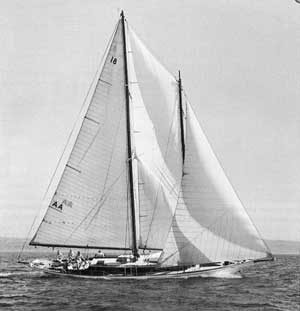
Now, Ted Geary was not just a designer and sailor, he was also a
born salesman. The following year, 1923, to the delight of Mr. W .J. Hole,
Geary delivered the beautiful Blanchard built SAMONA - a 115', triple-screw,
stabilized, rosewood-paneled and - furnished motoryacht! At times, while
building her, Blanchard's crew reached as many as 70 workmen, and it took
eight months for them to fashion the interior paneling, furnishings, and
, joinerwork from the rosewood logs supplied by the owner. One of
SAMONA's special features was a rosewood piano built by Ted's father, W.S.
Geary; today that instrument is in the home of Ted's daughter, Sharon Geary
(Adamson) Gee.
SAMONA and Willits J. Hole must have had a very symbiotic relationship:
Hole's health improved, and by 1925 he had made two trips to Alaska, two
to Mexico, and one of more than 12,000 miles from Los Angeles to Central
America, the Panama Canal, Colombia, Santo Domingo, Haiti, Puerto Rico,
and Venezuela, going some 350 miles up the Orinoco River. By 1930, when
he ordered the 147' steel-hulled SAMONA II, again from Ted Geary, Willits
J. Hole had cruised more than 50,000 miles and become a world traveler
and internationally recognized sport fisherman.
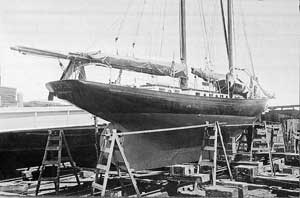
The first SAMONA was similar in profile to the 90' WANDA, built
in 1922 for Seattle lumber baron C.D. Stimson. WANDA was also triplescrew
with a top speed of 20 mph with her three Speedway 175-hp, eight-cylinder
gasoline engines. Cruising at 15 mph, she had a cruising range of 1,250
miles with three 500-gallon fuel tanks. WANDA had a double-planked and
glued-seam Port Orford cedar hull with no caulking. Thol Simonson, who
owned her for 20 years in the 1970s and '80s, says that in all that time,
and despite some extensive cruising, her seams never showed. "Her topsides
were as smooth as glass the whole time I owned her." Today, WANDA is owned
on San Francisco Bay.
Geary was still in his late 30s when he designed SAMONA and WANDA, yet he had become the designer of choice among the Seattle boating community. Orders were also beginning to come in from southern California. And, while the elegant plumb-bow-and-steamer-stern motoryacht was evolving to perfection on his drafting board, he was also designing some large and handsome sailing yachts. First, in 1920, was KATEDNA, a 60' schooner for Seattleite Fred Baxter. (Subsequently renamed RED JACKET, she made yachting history over the next four decades, and on several occasions won the Swiftsure Race. Today, RED JACKET sails out of Tacoma, Washington.)
Another schooner, the 58' AAFJE, followed KATEDNA down the ways at Blanchard's in 1922. She sailed south early in her career, and had several owners over the years. Among AAFJE's trophies was a third place in the 1928 Transpac, and she was an active racer for many years.* Yet another schooner, the 57' SUVA, built by Quan Lee in Hong Kong in 1925, is still sailing today and has been owned in the Seattle area since new.
Though few in number, these sailing yachts underscore their designer's talent and versatility. But Seattle in Geary's day was not an area that particularly encouraged the development of large cruising sailboats, which explains why his sailboat designs were so outnumbered by his motoryachts.
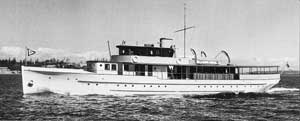 |
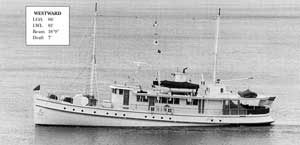 |
In the light of such work, it is surprising that Ted Geary did not become involved in designing fast rumrunners (he was no teetotaler himself), but it seems the opposite was true. A newspaper article of 1924 reported that Mr. Geary would be unable to race SIR TOM in the Pacific Coast Regatta that year, as he had been named supervising architect for 15, 75' government rum chasers to be built by Lake Union Dry Dock & Machine Works. There is no evidence that Geary designed any of their opposite number.
By 1926, the commuter boats were being superseded by large motoryachts as Geary's principal work, and he now found himself with so much business that he employed assistant draftsmen in the office - among them were H.C. Hanson, Carl W. Shield, Acme Mansker, and Ed Monk, Sr. The 122' SUEJA III, built in 1926 for Capt. James Griffiths, was typical of the designs coming from Geary's board at this time. Built at Griffiths's own yard, Winslow Marine Railway and Shipbuilding Company at Eagle Harbor on Bainbridge Island, she was unique in being built entirely of Oriental hardwoods, cut and fashioned in Hong Kong and then shipped to Eagle Harbor for assembly. Keel, keelson, frames, and all longitudinal members were of yacal, as was the hull planking below the waterline. Topside planking, decks, and all joinerwork were teak. Griffiths was a frugal man, and considerable money was saved by this method of prefabrication. He was also a generous man, having been one of the principal sponsors of Geary's MIT education, and the two men had maintained a close working relationship since those days. In 1919 Ted had designed an earlier 82' SUEJA for Griffiths, and he not only designed but also supervised the building of SUEJA III, a yacht that cruised over 11,500 miles in her first year.
In quick succession through the mid-1920s, and all of them typical of Geary's design work of the time, came GOSLING (75'), WESTWARD (86'), HERMINA (65'), JESIMAR (82'), and MALIBU (100'). GOSLING and MALIBU were for southern California owners, and it is of interest that only HERMINA and MALIBU were built by NJ. Blanchard Boat Company; GOSLING was launched by Lake Union Dry Dock Company, JESIMAR by Ballard Marine Railway in Seattle, and WESTWARD by J.A. Martinolich at Dockton, Washington.
With so much profitable work in hand, one might assume that Ted Geary became tied to his drafting table; and yet, in 1926, his talents as a racing skipper were called upon by his friend and client Don Lee, a California businessman and yachtsman. Lee had bought the 136' steel schooner INVADER, designed by A.S. Cheseborough and built by Lawley in 1905. He had his mind set on breaking the elapsed-time record of 11 days, 14 hours, and 46 minutes for the Los Angeles-to-Honolulu Race. The record had been set three years earlier by the 107' Starling Burgess schooner MARINER. Lee asked Ted to be sailing master, to prepare the boat in all ways for the race, and to recruit the crew to achieve the goal. Considerable redesign and upgrading of INVADER's gear was required, and nothing was spared in the effort. Ted obtained the services of his boyhood friend, Lloyd Johnson, to supervise the work and to be a member of the crew. Other crew included Owen Churchill, Pierpont Davis, Swift Baker (a SIR TOM crew member), and Ray Cook-in all, there were 20 professional crewmen and 10 Corinthians.
INVADER faced some formidable opponents in the race: MARINER, recently purchased by the actor John Barrymore, was entered again, and, so too, was the 107' POINSETTIA (later CONTENDER), designed by C. Stockhusen and built in 1905 by G. Seebeck of Bremerhaven, Germany.
Of all his experiences in sailing and racing, Ted believed that his most exciting moment came during that Honolulu race, recalling, "My most thrilling sail in 30 years of yachting, was the first night out on the 1926 Transpacific Race. In a half gale we averaged 15 knots for seven hours with the wind square abeam and under full sail-with main club topsail, jib top, foregaff top, and fisherman. This amount of breeze was unexpected before sunset, and the fear of damaging our kites and making them unusable when needed later caused us to leave them up and hope the wind would diminish. Gradually our steel bulwarks were under water and the seas were washing across the lee deck like a mill race. The main deck was often under 3' of water from bow to stern. Not a thing let go except about $2,000 worth of loose gear that had been improperly secured or stowed. Not a line or halyard parted, or sail blew out, although the lee lifeboat was capsized in her davits."
INVADER ran well, and halfway through the race she was a full day ahead of MARINER's 1923 position, with noon-to-noon runs of 269, 300, and 258 miles, along with five more days averaging over 210 miles. Then came some unseasonable weather - the trades quit, and it took INVADER 22 hours to sail the last 35 miles. She missed the record by 12 hours and 2 minutes, even though she won the race on both elapsed and corrected times. Her crew's disappointment was somewhat mollified by winning the return race to San Francisco against the northeast trades in 13 days, 5 hours, and 45 minutes, besting MARINER's previous record of 14 days and 18 hours.
Writing about this race 52 years later for the History of the Transpacific Yacht Club, Owen Churchill recalled, "We really went first class: one chef, two assistant cooks, and one steward. Not one drink was taken [while] racing over. We raced! Then we raced back to San Francisco and beat the hell out of MARINER and POINSETTIA. We drank going home!"
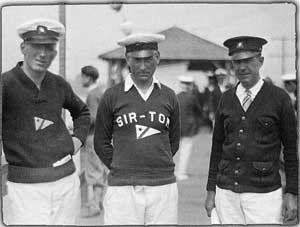 |
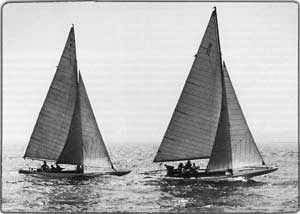 |
